Created by Nicolas Caminero, Andrew Franks, Ananya Kapoor, Abena Ofosu, and Jasmine Vonk
Artist’s Statement
Finding Ophelia is a transmedia game that uses a mix of analog and digital gameplay to lead players on an immersive journey through a series of puzzling mysteries. Centered around the quest of Violet, an 18-year-old freshman at St. Belfry University, to find her missing friend, Ophelia, the game creates an intriguing narrative that combines elements of suspense, eerie mystery, and emotional storytelling.
Our intention for the game was to immerse players in a suspenseful narrative of mystery and courage, set against a backdrop of dark academia. The game’s dark, brooding aesthetic is designed to reflect the inner turmoil of our protagonist as she delves into the murky depths of St. Belfry’s secrets. We sought to evoke a sense of ominous dread, mirroring the best of thriller novels, but also underscored by an emotional narrative about friendship and the lengths one would go to save a loved one. Each game element, from the narrative to the puzzles, was crafted with the aim of maintaining this emotional resonance and sustaining an atmosphere of suspenseful anticipation.
System Map
Our game employs a mixed-media approach, combining analog and digital elements to create a rich gameplay experience. The analog components, such as newspaper clippings and a journal, provide a tactile, personal connection to the narrative. The digital platform complements this by adding an interactive dimension, introducing puzzles that need to be solved on a dedicated website, and progressing the narrative based on players’ inputs. Below we have included a concept map of the game’s mechanics.
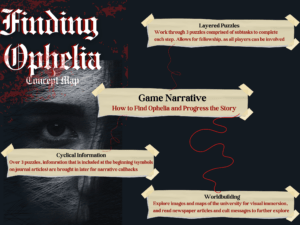
Formal Elements
Values
When we were first deciding the elements of our game, we wanted to create something that would allow players to immerse themselves into our world while also being pushed to overcome obstacles. Thus, Finding Ophelia encourages players to (1) engage with the story, (2) imagine a realm with a compelling system, and (3) challenge themselves through puzzles.
(1) Engage with Story
As players complete our game, they will progress through Ophelia’s journal to learn more about the activities she was up to before her disappearance. They will also learn more about St. Belfry University and its environment. Thus, we hope that they will become invested in the narrative’s main arc and become consumed by the desire to save Ophelia.
(2) Enter a New Realm
Due to the cult nature found within our game, Finding Ophelia offers a space for players to engross themselves with a reality that they are not familiar with. As they complete the puzzles contained within our Escape Room in a Box, they will gain more information behind the cult’s behavior. More specifically, players will learn the various imaginative ways that the cult communicates its messages.
(3) Challenge Themselves
Our game also includes a series of puzzles that players must solve to locate and save Ophelia. Each puzzle contains its own number of subproblems so that players must take additional time to understand the information and artifacts they are being given and how they relate to each other. Thus, these serve as barriers that they must surmount to successfully beat our game.
Initial Decisions
While developing our game, we brainstormed how each formal element of gaming would function in Finding Ophelia. Each one is described below.
Players: Anyone that plays our game is working to rescue Ophelia before the cult harms her. Thus, our game can include 1 – 4 players so that Finding Ophelia can either be a single player game or cooperative play.
Objective: The primary goal of our game is to figure out where the cult is hiding Ophelia. Players will do this by working through each puzzle to figure out the cult’s secret phase as well as their hiding location.
Rules and Procedures: We have included an instruction sheet that onboards players to start their journey for Finding Ophelia. Players are encouraged to work through each puzzle one at a time, which is suggested by the ordering of Opheli’s journal entries. Besides, there are no specific rules except for the fact that the game is optimized for no more than 4 players.
Resources: Our game comes in a box that includes all the materials players will need, including puzzles, a journal with entries, scratch paper, etc.
Boundaries: Finding Ophelia does not have a physical boundary, However, the game is most enjoyable if players have a large table space so they can keep track of all puzzle pieces. It’s also best if players are in close proximity so they can work together to solve the puzzles.
Outcomes: If players have managed to correctly obtain the secret phase and the location of where Ophelia is being held, then they will win the game.
Use of Space, Narrative, and Puzzles
In constructing our game, our primary objective was to convey the narrative and move the player through the figurative narrative space through the physical materials provided. As the player reads our newspaper articles and journal entries and studies our photographs, the player can piece together a mental representation of the secret society they’re investigating and follow along with the missing roommate, Ophelia, on her journey of discovery about the secret society.
The players learn about the mysterious origins of the secret society, linking it to a trail of disappearances spanning decades, and first work to piece together the secret phrase the society uses. They learn about the mysterious underground tunnels the secret society is thought to use to navigate the school out of sight, and then the players look for the secret meeting location of the society. Armed with the secret phrase to unlock the uncovered secret location, the players are able to “save’ their missing roommate Ophelia and uncover the secrets of the no-longer secret society. Thus, through exploration of the physical materials and the solving of the puzzles the embedded narrative unfolds.
The puzzles are intertwined in a way that encourages players to take a second look at materials they used previously and look for connections. Players are pushed to read the journal for hints to start them on the right path for each puzzle, with each puzzle corresponding to certain entries that walk the players through the game, and revisit the newspaper articles for puzzles 1 and 3. Overall, each part of the game was crafted with the intention of serving multiple technical purposes in the puzzles while all serving the supplementary purpose of adding to the gothic, mysterious narrative.
Exploring Course Concepts
Throughout our game, we integrated various course concepts into our design, including:
Challenge: ‘Finding Ophelia’ employs the mechanic of having players investigate physical materials like newspaper clippings and journal entries to piece together the narrative and determine the secret phrase and location. The mechanic of solving puzzles creates a dynamic of investigative work and creative thinking, enabling the fun of challenge as players are challenged to think outside of the box and uncover the truth.
Fellowship: For the players that opt to play with friends, the game leverages the mechanic of working collaboratively in a small team to look at different elements together or in parallel and piecing together each other’s understandings to enable the dynamic of teamwork. Each player’s unique perspective of the materials and story is valued and brings the entire team one step closer to solving the puzzle. This dynamic of teamwork creates the fun of fellowship, bringing players together as they collaborate to solve the puzzles and win together.
Embedded Narrative: The mystery-in-a-box design was chosen to bring out the narrative through the exploration of all the different pieces. As players investigate photos and written pieces, the narrative of finding your missing roommate who was investigating a secret society on campus unfolds. Players are brought into the narrative space and encouraged to explore the narrative in order to solve puzzles and finish the game.
Design Process
Puzzle 1
The first puzzle of Finding Ophelia involves a hunt where players must find symbols across several newspaper photos and decode them to acquire the first part of the secret phase. To do so, they must look out for symbols on a cipher that is provided for them. Since players are not familiar with the symbols, we expect them to struggle in finding the symbols from each photo. Furthermore, players must place the symbols from oldest to newest (each will correspond with a newspaper date) to successfully input the right word.
When we first selected the photos for this puzzle, we originally included 10 news articles and photos. Six of the photos actually included symbols, while the other four did not have any. However, as we were making our game, we learned in class that Escape Boxes should not include red herrings within their puzzles. This makes for a less enjoyable experience for our players, since they already do not know what they should be searching for.
For this reason, we got rid of the unnecessary photos. We also changed up the pictures and the placement of the symbols so that they would be harder to find. We also included dates on the actual photos so that players would be able to detach them from the news articles without losing their corresponding date. These can be found here.
After conducting a playtest, we received some input that the photos having dates made the players completely disregard the content of the news articles. Since the news articles contain important world building information and would also be used in the third puzzle, we did not want future players to completely ignore them. Thus, we decided to remove the dates and paperclip them to the news articles instead. Here is the last iteration of the photos we selected.
Lastly, we also added a newspaper-like background to the articles so they could fit with our narrative. We did this in hopes that it would make players more immersed in our world.
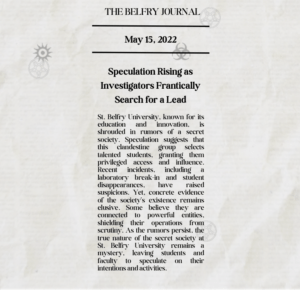 Puzzle 2:
Puzzle 2:
Our second puzzle requires players to solve a maze in order to obtain the second part of the cult’s secret phase. The maze depicts a series of St. Belfry’s underground tunnels and explains how the cult is able to move across campus quickly. However, the maze is lined with symbols that are etched into the stone’s surface. This is illustrated by the various symbols that are spread throughout the maze below.
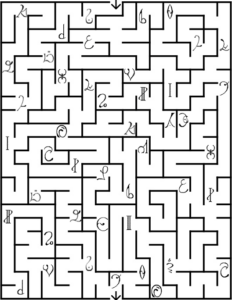
However, simply solving the maze would prove to be too easy for our players. Thus, we wanted them to have to decode a letter between cult members so that we could add an extra layer of difficulty to the puzzle. In the maze, players must only use every symbol letter along the solution’s path in order to obtain the correct phrase. They must solve that only every third symbol is used by noticing that every third word in the cult letter is in a different font. Of course, the letter and journal entries will allude to this fact by their contents.
When we first designed the cult letter, we used two different fonts to convey the pattern and its correlation to the maze. We chose to do a black aesthetic background to match the cult theme. However, the first choice of fonts that we used were too similar in nature and made it difficult to distinguish the font pattern. Thus, we redesigned the cult letter so that the pattern could be easier seen by our players. The changes can be seen below.
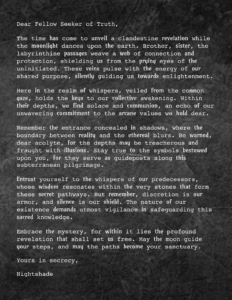
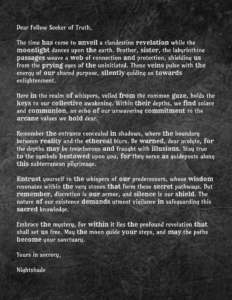
Puzzle 3
Our third puzzle is a map-based puzzle where players must use wax paper to identify a pattern of various symbols from the journal articles, then use that overlay to identify which map is correct. On the overlay is an ‘X’ that aligns with a specific location on the correct map. If players use the wrong map, then the ‘X’ will line up with the wrong location.
For the first map, shown below, we attempted to use a map from the University of Iowa and overlay the symbols on that map. However, we quickly found that the map would be too blurry and our map would benefit from a more stylized, customized map. For example, we wanted to be able to name the buildings ourselves to maintain theme cohesion: having Belfry Cathedral, for example.
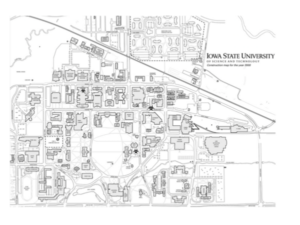
Therefore, for the second map, shown below, we finalized a rough outline of our map and key, then began experimenting with the symbols. For example, we added multiple symbols across the map that matched an identical hint on the puzzle’s corresponding journal entry. However, that puzzle was quickly completed.
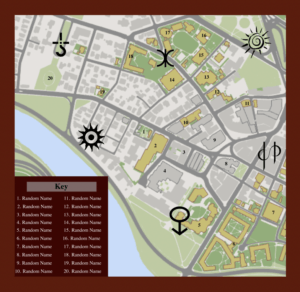
As a result, for the final maps, we created multiple different, nearly identical maps. However, the correct map is the one that has symbols in the same position as they are in the newspaper articles. This requires first building an overlay by tracing each symbols location from the newspaper articles and then cross referencing with each map. This solution also provides purpose for the newspaper articles, which had previously only been relevant for world building.
Playtesting
Playtest 1
- What we were testing
- Puzzle 1
- We were looking for feedback on photos that had the symbols hidden in them – we wanted to see how easy/difficult it is to find the symbols and place them in the correct order by checking the dates from the newspaper articles
- Puzzle 2 – This was more of feedback from Shana about our idea for puzzle 2. We wanted to incorporate a maze for tunnels in the university that would tie to our overall theme.
- Puzzle 1
- What we learned/observed
- Puzzle 1
- Symbols for some pictures stand out too much
- We realized this because people found them too fast
- So we decided that we should integrate them more into the landscape to make it more challenging for our players
- We realized this because people found them too fast
- Symbols also aren’t very clear
- Due to editing, some symbols lost clarity and players were unsure whether something was a symbol or not
- The photos currently do not coordinate with the newspaper articles
- There was nothing tying together the photos and newspaper articles
- Symbols for some pictures stand out too much
- Puzzle 2
- We can string letters all throughout the maze and the path goes through letters in the order that forms the second phrase
- Can add the component of ignoring certain letters along the path to make it more challenging
- Idea for tying it together: the maze is the hidden tunnels under the university that the cult uses to get around the university unseen — make a journal entry reference this part of the plot like “how does the secret society get around unseen?” & newspaper clipping that reference a rumor that the university has underground tunnels
- We can string letters all throughout the maze and the path goes through letters in the order that forms the second phrase
- Puzzle 1
- Changes we made
- Puzzle 1
- Made the symbols more clear and placed them in trickier positions so that they are not as easy to locate
- Added dates to the photos so that they can be matched to the newspaper articles
- Puzzle 2
- We strung letters throughout the path of the maze
- The maze only has one solution so that players are not stuck indefinitely trying to find the path with the answer
- Every third symbol is required and this is mentioned in a journal entry
- Puzzle 1
Playtest 2


- What we were testing
- How does the new placement of symbols work for puzzle 1?
- Is it still very easy?
- Are the symbols visible now?
- How does a player go about exploring the game when they are handed the journal entries, photos and newspaper articles? Is it intuitive? Or do they need some hand holding from our side?
- How does integration of the website to submit the answer work?
- Does it feel like a different thing altogether or does it blend in with everything else?
- How does the new placement of symbols work for puzzle 1?
- What we learned/observed
- Gilbert took his time to understand the puzzle
- He first looked at dates within the articles
- We think this might be because he felt that such text heavy articles definitely had to contribute to the answer
- He first looked at dates within the articles
- Overall playtest took 8-9 mins
- But he also took a good time reading through and understanding things – so this could have slowed him down.
- Journal entries were helpful to guide him through the first puzzle
- He did not need any hints from us.
- If he would have any questions, he would refer back to the journal entries and would be able to find his answer himself
- Found symbols quickly, but he wanted us to test this with more people as he tends to play a lot of games and is usually quite fast 🙂
- Suggested we make things less text heavy
- He spent time reading the newspaper articles, but did not actually end up using any of that for the answer.
- Suggested we give our players a pencil and paper for this puzzle
- He found it easier to solve the puzzle by being able to write down the word he was trying to find.
- Website was easy to use
- We did not have to explain anything to him and he was able to navigate through it himself
- Gilbert took his time to understand the puzzle
- Changes we made
- Made newspaper articles a little less text heavy
- So that players do not “waste” time reading through them. We still wanted them to add to the overall character
- Decided to provide players with a pencil and paper along with the game
- So that they could easily visualize their answers
- Made newspaper articles a little less text heavy
Playtest 3

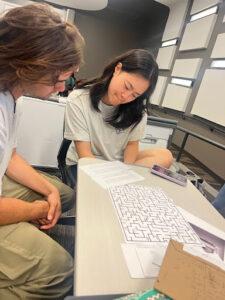
- What we were testing
- How does the game work with multiple players?
- This was our first playtest with more than 1 player
- Puzzle 1
- Are they able to navigate the game with what is given? Or do they require extraneous hints from us?
- Is finding the symbols still very fast?
- Puzzle 2
- How does this new puzzle integrate itself into the game? Is it easy? Tough?
- What do the dynamics of identifying that it is every third symbol look like?
- How does the game work with multiple players?
- What we learned/observed
- Puzzle 1
- They quickly figured out the photos were paired with newspapers
- They didn’t see the symbols at first (“i’m not seeing the symbols anywhere”)
- Started reading the newspaper articles instead of focusing on the photos
- This made us wonder if we need a way to keep them focused on the photos? Or is it okay to let them explore?
- Started writing down dates in addition to the symbols
- This was a sign that they were able to make the connection that the dates will have some role to play (ordering)
- Were confused about what order to go in for the dates (start with the oldest or most recent?)
- Figured out they were going in the wrong order on their own. This natural flow made it very escape room-like.
- Liked using the pencil and paper we provided
- Players definitely appreciated this touch as it made things easier for them – they did not have to recall anything from memory and could instead focus on the game.
- Couldn’t tell which order the word went in or if it was scrambled
- “This cant be right, it does not mean anything”
- We realized we should probably should provide more scaffolding that it’s in latin
- They liked the date thing but wondering what the word meant – feels like it should be relevant. They did not know what they were trying to find.
- “This cant be right, it does not mean anything”
- Took 11 mins to complete
- Video
- Puzzle 2
- They saw the maze and identified that it needed to be solved
- Found the path super fast from just staring at the maze for a bit
- Should we increase the complexity? (took like 2 seconds to find the path)
- Quickly understood the every third letter principle
- We should make this a little more challenging
- Found the path super fast from just staring at the maze for a bit
- Thought the maze could be a little harder
- We did want to playtest this more as this could be one off
- Like Gilbert with the symbols
- Found decoding of symbols fun to do
- We could see that they were very excited at the idea of translating symbols into characters
- We did want to playtest this more as this could be one off
- Took 3 mins to complete
- Video
- They saw the maze and identified that it needed to be solved
- Puzzle 1
- Changes we made
- Puzzle 1
- Things look good, it was the optimal time we had wished for.
- They enjoyed finding the symbols and it was not too fast.
- They were also able to complete it using the information from the journal entries and did not need any extraneous hints from us
- We did decide to add somewhere in the journal entries that it is a latin phrase they are looking for,
- This was so that they do not get bogged down when they find a non-English word
- Things look good, it was the optimal time we had wished for.
- Puzzle 2
- We decided to make the part about understanding that it is every third symbol more trickier
- Decided to bold every third word in one of the texts for this puzzle to make it more subtle rather than explicit
- This would also increase the time taken to solve this puzzle and would allow it to combine more elements
- Decided not to change the maze for the time being
- Wanted to playtest it more
- Decided to bold every third word in one of the texts for this puzzle to make it more subtle rather than explicit
- We decided to make the part about understanding that it is every third symbol more trickier
- Puzzle 1
Playtest 4
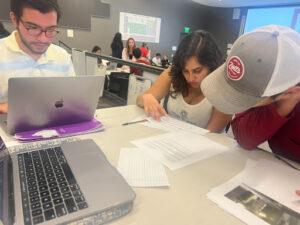
- What we were testing
- How is the experience of playing puzzle 1 and 2 together? How do they separate the material?
- We wanted to know this to get more information about how the game comes together
- Puzzle 1
- Do they understand that they are looking for a Latin/non-English word?
- Puzzle 2
- How fast is solving the maze?
- Can they identify that it is every third symbol?
- How do they use and interact with the fleshed out design of the website?
- How is the experience of playing puzzle 1 and 2 together? How do they separate the material?
- What we learned/observed
- Started veering off to puzzle 2 material, while working on puzzle 1
- But this is how escape rooms puzzles work, so its okay. We feel this adds to the element of challenge
- Puzzle 1
- Went straight to work on the first puzzle
- Noticed that symbols are in the pictures and that dates should be important
- Seeing the symbol translation sheet made them realize this was going to be a major part
- Identified that dates of pictures matched with dates of articles
- The dates on the pictures gave this away.
- Wrote symbols along with dates
- Realized that there is going to be some ordering
- Did not really engage with the content within the newspaper articles, just looked at the pictures
- They realized it might not be relevant as it is too text heavy
- Were still confused when it was not an English word
- How do we make this more salient?
- Took 8.5 mins
- Video
- Puzzle 2
- Thought that symbols should spell something out
- Took a decent time to solve the maze
- Checked for multiple paths, saw there is only one.
- Wrote all letters along solution’s path
- Put this entire word on the website and then got feedback it was wrong
- Realized they are doing something wrong
- Later noticed that every third word is in a different font
- Took 8 mins
- Video
- They liked that symbols were used in both puzzles
- It felt like it tied the game together and was a major theme
- Including picture with article would have made it harder perhaps, or made newspaper more relevant
- Started veering off to puzzle 2 material, while working on puzzle 1
- Changes we made
- Will include on the website that you are looking for a latin word for puzzle 1 and 2
- To make things more salient and not a source of unnecessary confusion
- We will remove dates from the pictures and pair the pictures with their respective newspaper articles
- So that they have to look at the articles for the dates. This would make the newspaper articles more relevant
- Will incorporate our symbols for puzzle 3 into the newspaper articles to make them more relevant (showed to Shana and she liked it)
- This continues on our intention of making the newspaper articles more relevant
- Puzzle 2 timing looks as intended and it was smooth (but not too smooth – just as we want it to be)
- They were able to figure out things themselves if they were blocked
- They did not feel lost at any point
- They enjoyed playing and remained engaged throughout
- Will include on the website that you are looking for a latin word for puzzle 1 and 2
Playtest 5

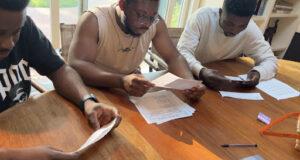
- What we were testing
- Puzzle 1
- How different would the experience be for 3+ players?(applicable to all puzzles)
- Is the point of the game clear from the beginning?
- Puzzle 2
- How well do the essays convey what the players need to do? Which visual choice would players make?
- Puzzle 3
- How do players use the various parts of the maps to find the spot? Does the wax paper seem intuitive to use despite the mention in the journal entry?
- Puzzle 1
- What we learned/observed
- Puzzle 1
- It was obvious that they were looking for a Latin word since it was explicitly stated(implemented feedback from previous playtest) on the website – ‘enter the first part of the Latin phrase’
- Since we had three playtesters, getting started was a little hard(extended reading). Coordination was initially an issue since they all wanted to learn about what they had to do. It is easier with <=2 people
- The materials provided were not enough for three so there had to be delegation of tasks among the players.
- Photos were held up to the light since the images were not that visible(playtest was during twilight) – lighting might be an issue if the game is played at night.
- Took 10:27
- Videos
- Puzzle 2
- They went along with the same format of the first puzzle initially.
- Different fonts were easier to read on white paper(found it more helpful) vs dark paper. However, they did not initially read it thoroughly due to verbosity.
- Comment: ‘the white one is better but the black one looks cooler’(paraphrase)
- Players found ‘Nightshade’ confusing(thought it meant something)
- Text on website “Enter the second word of the Latin phrase” was confusing. They said it sounded like they had to use the second phrase found in the maze. A good way to fix this is clearer wording.
- Took 16:27
- Videos
- Puzzle 3
- Players started guessing randomly what the location was by looking at patterns on the map. They also looked at the photos they initially saw in puzzle 1 to make an educated guess.
- It was not clear that they needed to use the content of the articles until moderator gave a hint.
- Use of wax paper was not readily obvious – the participants did not know how the wax paper was helpful for the last puzzle.
- Using the point of reference, they looked for the X that marked the spot. Finding location was surprisingly fast – an unforeseeable playout(which might be pure luck).
- Took 6:38
- Video
- Puzzle 1
- Changes we made
- Puzzle 1
- Adding the blurb from the box to the playtest
- This gave a fun insight to the point of the game. It gave the players an idea of what to expect on a high-level as they play the game.
- Adding the blurb from the box to the playtest
- Puzzle 2
- Changed the fonts on the cult letter
- This would make it easier for players to notice the pattern of every third word being a different font(puzzle 2)
- Readability for low vision players would be improved
- Changed the fonts on the cult letter
- Puzzle 3
- We would articulate that articles from puzzle 1 would be used in solving the last puzzle with the maps.
- This would help guide play sequence and make the process les frustrating as there are a lot of materials to be used.
- Add another journal entry to really help guide the player through puzzle 3
- We would articulate that articles from puzzle 1 would be used in solving the last puzzle with the maps.
- Puzzle 1
Final Playtest
Final Playtest Video Part 1:
Final Playtest Video Part 2:
Final Playtest Video Part 3:
- What we were testing
- The final game!
- What we learned/observed
- General stuff
- The entire playtest took 30 mins from start to finish
- They started by reading the instruction sheet
- Took their time to read through it
- They then started reading through the journal
- It felt intuitive and natural
- It did a good job at guiding them through the game
- They were able to identify early on that they are going to be looking for a latin phrase
- So unlike previous playtests, they never had an issue when the word they decoded was not an actual english word
- The journal however did feel too text heavy
- “How much of this is actually relevant?”
- Due to this, after a point, they randomly started going through the journal in no order
- But soon realized this was not the way to approach it
- Perhaps making the journal entries less text heavy would be nice
- They were able to identify that the pattern(symbols) play a big role in the game after they saw the cipher
- Puzzle 1
- They started looking at the symbols on the newspaper articles before the ones on the pictures
- But were able to course correct themselves
- The symbol finding for puzzle 1 was the right amount of challenging
- It took them time
- For one, they were unable to find it with the naked eye and had to use their phone’s flashlight
- They were able to identify that they had to place the symbols in chronological order
- They tried pressing enter on the website and that did nothing
- They thought it meant that they had the wrong answer
- But it was just the fact that they had to press the submit button
- They started looking at the symbols on the newspaper articles before the ones on the pictures
- Puzzle 2
- This one was the most challenging for them
- They were easily able to solve the maze
- Tried making a word from all of the symbols along the path
- “I don’t think this is it”
- Inputted it on the website and realized that it was incorrect
- Tried making a word from all of the symbols along the path
- Thought maybe the maze had shorter paths
- Checked and decided that was not true
- Tried going back to the journal entries at this point to check if the order is right
- They maze and letter (that guided you it was every third character) was on a different page and that led them to believe it was not linked
- Started looking at maps and unknowingly completed puzzle 3
- Thought maybe the letter has something to do with it
- Read it and disregarded it
- Just not able to identify its relevance
- Asked for a hint
- We should perhaps add a hints mechanism because they would have been stuck for a very long time had we not given them the hint
- We pointed them to the letter and the first word of every paragraph
- “It spells out “three”. What does that mean”?
- Were still confused what it meant
- Saw that every third word looked different
- Spent time confused
- It finally clicked that it was an offset of three
- “It spells out “three”. What does that mean”?
- Puzzle 3
- They were easily able to identify the odd one out map
- “It is the only black and white one, this has to be it”
- Were able to recall and go back to the newspaper articles to mark the symbols on the wax paper
- Were able to find the location easily by using the mark of X
- They were easily able to identify the odd one out map
- General stuff
Try It Out Yourself!
Wanna play Finding Ophelia? Download the print-and-play here. You can also download the website that goes along with the game here.
Accessibility
Below are a couple of ways in which we have optimized our game for accessibility, explicitly focusing on players with low visibility due to the fact that Finding Ophelia is primarily visually-focused:
Text Size Adjustment: To ensure that the game content is easily readable for all players, we have enlarged the text on our website. The larger text size not only draws the attention of the players but also enhances visibility for players with vision impairments.
Contrast Enhancement: We have adopted a high-contrast design scheme with white text on a black background. This color combination significantly improves text visibility, allowing players with low visibility to distinguish text elements more easily. The high contrast also reduces the strain on players’ eyes during gaming sessions.
Struggles and Learnings
We struggled with trying to find a balance for each of the puzzles and the overall game– we did not want things to be too easy or too hard and reaching that balance required lots of discussions and playtesting. Initially, we had red herrings in our game (such as extra photos for puzzle 1) – but after one of the guest lectures (that advised against it), we got rid of them.
We also had a tough time deciding how to layer puzzles with different components i.e using journal entries, symbols, photos, newspaper articles etc. all for one puzzle. We wanted to do this so that no puzzle is too simple and solving them is fun, engaging and a good amount of challenging. While we did this, we also wondered how much information to give the players.
Lastly, we wanted to add an autoplay sound to our website, but were unable to do so because of Chrome’s limitations for autoplay (we did not want to use any other browser because it made the website look funky). We could have added sound that the user started to play themselves, but decided against it as it would not be able to achieve the effect of autoplay.
Overall, we learned that the best way to improve was to test Finding Ophelia out on new players. During our iteration process, we took as many opportunities as possible to playtest our puzzles and narrative with new people. With each session, we absorbed what each player had to say and changed the game according to our own observations as well.
Keep on gaming gamers!
Your friends,
Team 11




